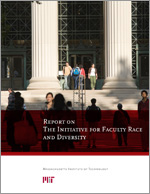Report of the Initiative for Faculty Race and Diversity
Our multi-method study has shown that URM experiences at MIT differ in significant ways from White and Asian faculty, even though, for the most part, there is the best intent from the Institute as a whole. Minority faculty are more likely to leave early, before the first promotion, and have less satisfactory mentoring experiences. Within the URM group there are also notable differences. Blacks, compared to Hispanics, seem to have a more successful career trajectory at MIT, and yet their experiences at the Institute are more negative. Black women's career trajectories are not as favorable as those of Black men, and their mentoring experiences are even worse. Hispanic women are so few that it is difficult to say anything significant about them, except to highlight their low number. While URM faculty gain from the privileges of their position at MIT, some among them are treated less well and work in a less welcoming environment, with their very belonging here occasionally questioned. These findings suggest that despite many encouraging attempts at MIT to diversify the faculty, there still are aspects of climate and culture that need to be examined.
While almost everyone at MIT would like the Institute to be an institution of merit and inclusion, it will be difficult to reach this ideal if race and ethnicity are ignored and presumed irrelevant. Granted, it is not easy to discuss issues of race, but a climate of silence may impede this goal. What complicates the situation is that the practices seen as problematic by the minority faculty are deeply embedded assumptions - taken for granted - at MIT, and their connection to race is not obvious. These assumptions need to be examined to understand their intended and unintended consequences. When seen through the eyes of the minority faculty, the practices that flow from these embedded assumptions are not always as objective or race-neutral as many hope and assume. For example, our practice, typically, is not to pay much attention to service. But if we ignore the racial taxation - the extra race-specific service of minority faculty - it not only discourages the faculty, but may also have a negative "trickle down" effect on minority students. If these students do not see the work of their teachers appropriately recognized, they may be less inclined themselves to join the academy. To make MIT a place that works equally well for all, and minimizes the risk that minority faculty are not seen or treated as equal, full members of the community, we may all have to become more aware of our tacit assumptions about race.
We hope that this report will help everyone to be more self-reflective, to better understand the lives of the URM faculty at MIT and to appreciate how race plays into their experiences. It is important to resolve the tension between excellence and inclusion, and to recognize how significantly they are connected. In Part I of this report we outline recommendations to undo the tensions around race, to improve the lives of minority faculty and to increase their number, recommendations that will also create a better climate for all. The implementation of these recommendations - informed by the research and input from faculty as well as efforts already in place - promises to enhance the academic excellence of MIT through the diversity of its faculty.
Authorship and Acknowledgements
The data in this part of the report were collected, analyzed and written by the research team: Lotte Bailyn, head; Mandy Smith Ryan for the quantitative analysis; Siomara Valladares and Carol Wright for the interviews with the minority faculty and the qualitative analysis. Ayn Cavicchi and Kathryn Sallis interviewed the White faculty, Ellen Wang the Asian. Ruquia Asghar gave helpful research assistance throughout and Scott Barge was invaluable in the final stages of the quantitative analysis. We also had generous help from our consultants: Sharon Fries-Britt and Clarence Williams, who did some of the off-campus interviews. Sharon Fries-Britt was also helpful in the final writing. The Race Initiative team helped guide our analysis throughout.
We are particularly indebted for help on the design and analysis process to our Technical Advisory Board: Joshua Angrist, John Carroll and Susan Silbey. Josh Angrist helped in the regression analysis, John Carroll provided support throughout and a final, careful reading of a draft of this report, and Susan Silbey worked with us on the qualitative analysis from beginning coding, through analysis, all the way to the final organization and writing of the findings. We benefitted as well from guidance on research design and analysis from the External Advisory Board, particularly Evelynn Hammonds, Samuel Myers Jr., Willie Pearson Jr. and Abigail Stewart.
MIT's Institutional Research in the Office of the Provost at MIT provided invaluable help,
especially Lydia Snover and Sonia Liou for the institutional data and Greg Harris for the faculty survey. We are grateful to Rita Geller and Adrienne McCosh from the compensation office in Human Resources for their help in accessing salary data and the office space to
perform the analysis, and also thank Provost Rafael Reif for giving us authority to access these confidential data.
Previous:
D. MIT: A Meritocratic Institution
of Excellence and Inclusion?
Next:
References for Research Report
L. Rafael Reif
Office of the Provost
Room 3-208
Massachusetts Institute of Technology
77 Massachusetts Avenue
Cambridge, MA 02139-4307
(617) 253-4500 phone
(617) 253-8812 fax

